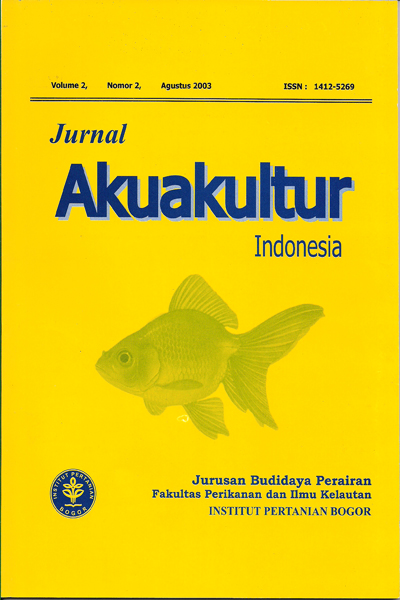Patogenesis of White Spot Virus Infection (WSV) on Black Tiger Shrimp (Penaeus Monodon Fab.)
Abstract
The pathogenesis determination of white spot disease on tiger shrimp to study effect of various white spot virus concentrations on pathological changes was conducted by water borne infection with the several of viral concentration within 60 minute using black tiger shrimp post larvae. The result showed the incubation period of the disease based on appeareance of white spot at 2-2000 ng/ml is 17 days p.i., whilst at 0.2-0.02 ng/ml is 19 days p.i. It seem, the lowest viral concentration stimulated respond immune of shrimp which indicated by low mortalities percentage (13.3 and 10.6%). Stage of disease development recognized throughout histological analyse, based on hypertropie of nuclei, is stage 0-4. Based on microscopic observation, the white spot seen pleomorphic forms which related to its development and seem to be used as rapid diagnostic tool for indicating of WS infection. This study also proved by histological observation that hepatopancreatic tissue can be infected as well as epidermis of carapace, gill, intestine and lymphoid tissues. One of pathological changes by WS infection is white spot as pathogonomic lesi of the disease.
Keyword : White spot virus, infectious disease, tiger shrimp (Penaeus monodon Fab.)Downloads
Authors who publish with this journal agree to the following terms:
- Authors retain copyright and grant the journal right of first publication with the work simultaneously licensed under a Creative Commons Attribution License that allows others to share the work with an acknowledgement of the work's authorship and initial publication in this journal.
- Authors are able to enter into separate, additional contractual arrangements for the non-exclusive distribution of the journal's published version of the work (e.g., post it to an institutional repository or publish it in a book), with an acknowledgement of its initial publication in this journal.
- Authors are permitted and encouraged to post their work online
 (e.g., in institutional repositories or on their website) prior to and during the submission process, as it can lead to productive exchanges, as well as earlier and greater citation of published work (See The Effect of Open Access).
(e.g., in institutional repositories or on their website) prior to and during the submission process, as it can lead to productive exchanges, as well as earlier and greater citation of published work (See The Effect of Open Access).






















